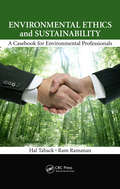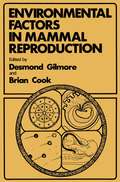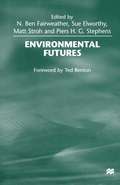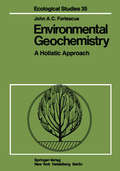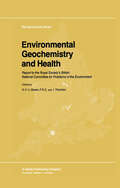- Table View
- List View
Environmental Ethics and Medical Reproduction
by Cristina RichieCarbon emissions of global health care activities comprise 4-5% of total world emissions, placing the health care industry on par with the food sector. The United States health care industry in particular expends an estimated 479 million metric tons of carbon dioxide per year -- nearly 8% of the country's total emissions. Health care impacts the environment through the use of resources needed to cure, treat, and prevent diseases; by extending lifespans; and by facilitating new births. In this book, Dr. Cristina Richie evaluates "medicalized reproduction" (MR) from an environmental perspective. From pre-conception gamete retrieval to in-vitro fertilization (IVF), to birthing suites, MR has an enormous carbon footprint. But, unlike other areas of high-carbon health care, such as organ transplantation or chemotherapy, medicalized reproduction does not treat, cure, or prevent disease. It is supported by an economized medical industry, and as such, is open for ethical scrutiny. Richie first situates MR within environmental ethics. Part I analyzes the numerous resources used for medical reproduction, emphasizing that MR is a voluntary lifestyle choice. Part II offers policy suggestions for sustainable MR, remaining sensitive to some individuals' desires to be parents coupled with the global push for medical and climate justice. The conclusion recognizes the obligation for environmental sustainability in all areas of life, including health care and family life.
Environmental Ethics and Medical Reproduction
by Cristina RichieCarbon emissions of global health care activities comprise 4-5% of total world emissions, placing the health care industry on par with the food sector. The United States health care industry in particular expends an estimated 479 million metric tons of carbon dioxide per year -- nearly 8% of the country's total emissions. Health care impacts the environment through the use of resources needed to cure, treat, and prevent diseases; by extending lifespans; and by facilitating new births. In this book, Dr. Cristina Richie evaluates "medicalized reproduction" (MR) from an environmental perspective. From pre-conception gamete retrieval to in-vitro fertilization (IVF), to birthing suites, MR has an enormous carbon footprint. But, unlike other areas of high-carbon health care, such as organ transplantation or chemotherapy, medicalized reproduction does not treat, cure, or prevent disease. It is supported by an economized medical industry, and as such, is open for ethical scrutiny. Richie first situates MR within environmental ethics. Part I analyzes the numerous resources used for medical reproduction, emphasizing that MR is a voluntary lifestyle choice. Part II offers policy suggestions for sustainable MR, remaining sensitive to some individuals' desires to be parents coupled with the global push for medical and climate justice. The conclusion recognizes the obligation for environmental sustainability in all areas of life, including health care and family life.
Environmental Ethics and Sustainability: A Casebook for Environmental Professionals
by Hal Taback Ram RamananEnvironmental Ethics and Sustainability: A Casebook for Environmental Professionals introduces a decision-making model constructed from the viewpoint that ethics are not about the way things are, but about the way things should be. The first part of the book covers natural human instincts, human attitude, treatment of other species and the natural
Environmental Ethics, Sustainability and Decisions: Literature Problems and Suggested Solutions
by Fabio ZagonariThis book provides a summary of the main concepts involved in environmental ethics, sustainability and decisions and a consistent sequence of environmental ethics, sustainability and decisions. It presents many environmental ethics, by focusing on maximising welfare within teleological approaches and minimising inequalities within deontological approaches. It presents many sustainability paradigms, by focusing on weak sustainability to maximise welfare and strong sustainability to minimise inequalities. Two main decisions are presented by focusing on policies (taxes, standards, subsidies, permits, protected areas, exploitation rights) and projects (CBA) towards efficiency to maximise welfare and policies (national laws/regulations, bilateral/multilateral agreements) and projects (MCA) towards equity to minimise inequalities.
Environmental External Costs of Transport
by Peter Bickel Rainer FriedrichTransport is very important for the economy and our welfare. However, transport also causes a lot of problems, including air pollution. Such problems should be taken into account, when making decisions. A prerequisite for doing so is, that the impacts are known, quantitatively measured and allocated to the different activities in transport. Furthermore, they should be transformed into monetary units to be used as a basis for cost-benefit analyses or as an aid for setting taxes and charges, that reflect the external costs. This book describes a methodology for calculating impacts of transport activities and external costs caused by air pollution and presents numerous applications of this methodology for different transport technologies, locations and policy case studies. The approach has been developed and results have been calculated within the research project 'ExternE Core/Transport', financed to a large extent by the European Commission, Directorate General Research. We would like to thank especially Pierre Vallette and Pekka Jarviletho from the EC for their advice and support. A considerable number of experts with expertise in the different disciplines of this highly interdisciplinary work contributed to this book. The editors would like to thank the authors (see list on p. XV) for their contributions; it is especially remarkable, that the authors helped to make this book an integrated whole instead of a number of independent contributions.
Environmental Factors in Mammal Reproduction: (pdf) (Studies in Biology, Economy and Society)
by Desmond Gilmore Brian CookEnvironmental Factors in the Pathogenesis of Cardiovascular Diseases (Advances in Biochemistry in Health and Disease #30)
by Devendra K. Agrawal Dragan M. DjuricEnvironmental conditions and processes are one of the major pillars on which the human well-being rests. It is the core responsibility of the society to preserve and enhance better conditions for the human well-being. Indeed, there are several evolving unmet needs in public health. Emerging and re-emerging infectious diseases and a surge in the incidence of non-communicable diseases, including cardiovascular diseases (CAD), chronic respiratory diseases, and metabolic diseases have been impediments to sustainable well-being. Many factors are critical in the global surge in the rate and incidence of cardiovascular diseases. These include the shift from acute to chronic conditions, the shift from single risk factor vs. multiple influences, aging population, global health disparities, exposure to lower harmful influences over a longer period, etc. However, the epigenetic factors due to unhealthy environment play a most significant role in the underlying pathogenesis of cardiovascular diseases. Unfortunately, this has been ignored for a long time and realized lately to expand and disseminate knowledge to general population, expand research activities to investigate the cellular and molecular mechanisms, and develop better preventive and treatment strategies. The most significant environmental impoverishment in the pathogenesis of cardiovascular diseases include different genetical, chemical, physical, and biological influences, but not limited to, socio-economic status and lack of nutrients, nutritional aspects including habits, diets and additives, inhaled and ingested pollutants, exhaust gas and gasoline products, tobacco smoke, water pollution, alcohol consumption, soil and mineral pollution, solvents, pesticides, microplastics, non-critical usage of drugs, climate change, extreme atmospheric conditions, extremes in noise and temperature, electromagnetic influences, microwaves and radiation, outdoor light pollution, mental stressors, lack of or over exercise, microbiota and microbiological agents like SARS CoV-2 virus, etc.
Environmental Fate and Effects of Pulp and Paper: Mill Effluents
by Mark R. ServosIn recent years, there have been emerging concerns regarding the fate and effects of pulp and paper mill effluents on the environment. Countries throughout the world are focusing attention on the implementation of regulatory and monitoring programs. In response, industry has begun to implement a variety of process and treatment technologies designed to minimize or eliminate the potential impacts.Environmental Fate and Effects of Pulp and Paper Mill Effluents explores the most active and critical current research and experimentation from around the world. This comprehensive overview examines the identity and origin of chemicals in pulp mill effluents, environmental fate of chemicals from pulp and paper mills, bioaccumulation of substances from pulp mills to fish and wildlife, field and laboratory studies of biochemical and whole organism responses associated with pulp and paper effluents, integrated monitoring and future research, and policy directions of this rapidly evolving field.Written by prominent scientists from around the world with contributions from industry, government, and academia, this important new book provides a balanced global perspective of the recent scientific findings and the challenges being faced in the immediate future.
Environmental Fate and Effects of Pulp and Paper: Mill Effluents
by Mark R. ServosIn recent years, there have been emerging concerns regarding the fate and effects of pulp and paper mill effluents on the environment. Countries throughout the world are focusing attention on the implementation of regulatory and monitoring programs. In response, industry has begun to implement a variety of process and treatment technologies designed to minimize or eliminate the potential impacts.Environmental Fate and Effects of Pulp and Paper Mill Effluents explores the most active and critical current research and experimentation from around the world. This comprehensive overview examines the identity and origin of chemicals in pulp mill effluents, environmental fate of chemicals from pulp and paper mills, bioaccumulation of substances from pulp mills to fish and wildlife, field and laboratory studies of biochemical and whole organism responses associated with pulp and paper effluents, integrated monitoring and future research, and policy directions of this rapidly evolving field.Written by prominent scientists from around the world with contributions from industry, government, and academia, this important new book provides a balanced global perspective of the recent scientific findings and the challenges being faced in the immediate future.
Environmental Fate and Transport Analysis with Compartment Modeling
by Keith W. LittleEnvironmental Fate and Transport Analysis with Compartment Modeling explains how to use the powerful, highly flexible, and intuitive compartment approach to estimate the distribution of chemical contaminants in environmental media in time and space. Add this Easy-to-Use Approach to Your Environmental Modeling ToolboxThis numerical technique enables
Environmental Fate Modelling of Pesticides: From the Laboratory to the Field Scale
by Otto Richter Bernd Diekkrüger Peter NörtersheuserThis book is concerned with modelling the fate of organic substances in the soil. Once a chemical enters the soil it is subject to various transformation processes. It partitions between the liquid, solid and gaseous phase, it is sorbed to different binding sites with a different strength of bonding, it may decay by a simple chemical process or it may be transformed by microorganisms. Solute transport through soil and subsurface is mediated by water flow and is strongly influenced by solute sorption. To complicate matters, soil structures are heterogeneous. All these processes are embedded in a spatio-temporal hierarchy. The book brings together many different aspects of environmental fate modelling of pesticides comprising such diverse subjects as, e.g., compartment theory, nonlinear biological degradation models, modelling toxicity, parameter identification, coupling of physical and biological processes, pedotransfer functions, translation of models across scales, coupling geographical information systems with models, and FUZZY-approaches.
Environmental Finance for the Developing World
by Michael CurleyFinancing the Global Environment examines the financial techniques and strategies necessary to obtain funding to undertake infrastructure and environmental projects. Despite conventional notions that monies are typically not readily available for large-scale environmental projects, the book explains how this is usually not the case, and will provide the necessary steps, tools, and organizational methods necessary for successful project finance in any region. It demonstrates how the largest possible projects could be undertaken at the lowest possible cost and how a utility’s excess operating income could be used to improve the system. Features: Presents methods for the sourcing of funds and for maximizing income Defines what types of income can be used for making debt service payments and how it can be estimated Explains the basic concepts of loans and debt, as well as the present value theory of money This book serves as a useful guide for practicing professionals, industry executives, and government officials who work with water and wastewater utilities and infrastructure and are involved with financial project preparation.
Environmental Finance for the Developing World
by Michael CurleyFinancing the Global Environment examines the financial techniques and strategies necessary to obtain funding to undertake infrastructure and environmental projects. Despite conventional notions that monies are typically not readily available for large-scale environmental projects, the book explains how this is usually not the case, and will provide the necessary steps, tools, and organizational methods necessary for successful project finance in any region. It demonstrates how the largest possible projects could be undertaken at the lowest possible cost and how a utility’s excess operating income could be used to improve the system. Features: Presents methods for the sourcing of funds and for maximizing income Defines what types of income can be used for making debt service payments and how it can be estimated Explains the basic concepts of loans and debt, as well as the present value theory of money This book serves as a useful guide for practicing professionals, industry executives, and government officials who work with water and wastewater utilities and infrastructure and are involved with financial project preparation.
Environmental Flotation Engineering: Volume 12 (Handbook of Environmental Engineering #21)
by Lawrence K. Wang Mu-Hao Sung Wang Nazih K. Shammas Donald B. AulenbachThis volume covers topics on humanitarian engineering education of the Lenox Institute of Water Technology and recent advances in potable water and wastewater flotation processes. The specific advancements covered include: chemical coagulation and precipitation enhancements, first wave of flotation advancement for potable water treatment, second wave of flotation technology advancement for wastewater treatment, innovative circular gravity flotation, fiber detection, fiber separation, independent physicochemical wastewater treatment systems, primary flotation clarification, secondary flotation clarification, tertiary treatment, activated sludge and flotation wastewater treatment, cold weather wastewater conditions, operation and performance of the AquaDAF process system, operation and performance of the Clari-DAF process system, water purification, spectrophotometric determination of dissolved proteins, biological and physicochemical sequencing batch reactors, and sedimentation and flotation comparisons. The book will be of value to advanced undergraduate and graduate students, to designers of flotation systems, and to scientists and researchers.
Environmental Fluid Mechanics: Memorial Volume in honour of Prof. Gerhard H. Jirka
by Wolfgang RodiThis book contains the written versions of invited lectures presented at the Gerhard H. Jirka Memorial Colloquium on Environmental Fluid Mechanics, held June 3-4, 2011, in Karlsruhe, Germany. Professor Jirka was widely known for his outstanding work in Environmental Fluid Mechanics, and 23 eminent world-leading experts in this field contributed to
Environmental Footprints: Assessing Anthropogenic Effects (SpringerBriefs in Environmental Science)
by Kai FangThis book focuses on environmental footprints that have attracted considerable interest and discussion within academia, policy makers and the public as a tool to assess anthropogenic effects on the environment. It begins with an overview which provides a starting point for understanding the concept of environmental footprints. On the basis of a thorough investigation into the theoretical and methodological aspects of selected environmental footprints that have been widely adopted, a unified framework for structuring, categorizing and integrating various footprint indicators is established. Furthermore, the book brings clarity to the relationship between footprint analysis and life cycle assessment, and challenges the isolation of environmental footprints and planetary boundaries. The findings provide novel insights into the development of environmental footprints for environmental impact assessment and environmental sustainability assessment.
Environmental Footprints of Crops (Environmental Footprints and Eco-design of Products and Processes)
by Subramanian Senthilkannan MuthuThere are multiple variants of environmental footprints such as carbon footprint, ecological footprint, water footprint, nitrogen footprint and so on. There are numerous developments in terms of measuring the environmental footprints of various products. Many new indicators are being developed in terms of footprints to measure the environmental performance of various products. The need to measure various environmental footprints of agricultural crops is obvious and does not need any explanation these days when the importance of sustainability is felt so much and being practiced in all industrial sectors, including agriculture. This book presents five interesting chapters pertaining to environmental footprints of crops.
Environmental Footprints of Packaging (Environmental Footprints and Eco-design of Products and Processes)
by Subramanian Senthilkannan MuthuThis book presents detailed discussions concerning the environmental footprints of various packaging systems and materials, life cycle assessments of packaging, sustainable design of various packaging systems and materials, as well as the biodegradation of various packaging materials.
Environmental Footprints of Recycled Products (Environmental Footprints and Eco-design of Products and Processes)
by Subramanian Senthilkannan MuthuRecycling is the need of the hour and it is an inevitable destination at the end of the life of any product. Today, recycling can happen at postindustrial and post-consumer states and the importance of recycled products in the market has gained significant importance. Recycled products dominate the array of sustainable products in today’s context. Even though there are commercial implications for recycling, one of the very important and obvious reasons to go for recycling and to have recycled products is to have the benefits on environmental sustainability. It is highly important to assess the environmental footprints of recycled products and further improve the environmental benefits of such recycled products. This book presents five interesting chapters pertaining to the environmental footprints of various recycled products.
Environmental Forensics Fundamentals: A Practical Guide
by Ioana Gloria PetrisorA Practical Guide to Environmental Crime Scene InvestigationsReleasing contaminants into the environment-whether deliberate or unintentional-can be thought of as a crime against the environment. The role of environmental forensics is to identify and prevent environmental pollution, or crimes. Environmental Forensics Fundamentals: A Practical Guide
Environmental Futures
by Ben Fairweather Sue Elworthy Matt Stroh Piers H. G. StephensThe book comprises thirteen papers on environmental issues, with particular reference to future developments (for example, new technologies, paths in social and political theory, methodologies). It is divided into three sections, moving from social constructions of 'the environment' in the first section to questions of green political theory and practice in the second, and concluding with issues of environmental risk and future technologies. The work is interdisciplinary, with contributors ranging from philosophers to human geographers.
Environmental Genomics (Methods in Molecular Biology #410)
by C. Cristofre Martin and C. Cristofre MartinHere is a manual for an environmental scientist who wishes to embrace genomics to answer environmental questions. The volume covers: gene expression profiling, whole genome and chromosome mutation detection, and methods to assay genome diversity and polymorphisms within a particular environment. This book provides a systematic framework for determining environmental impact and ensuring human health and the sustainability of natural populations.
Environmental Geochemistry: A Holistic Approach (Ecological Studies #35)
by J. A. FortescueIt is the policy of the federal Canadian Forestry Service to sponsor research initiatives from the private sector that are judged to be pertinent to its mandate and offer particular promise towards the optimal management of Canadian forest resources. This book is based on such an initiative. It represents the philosophy of the author himself and is in no way constrained by the views of the sponsoring agency. Over the past two decades Dr J. A. C. Fortescue has become well known at a number of research centers throughout the world. He has pioneered the approach to environmental understanding that is comprehensively developed in this text. The limitations of traditional compartmentalized approaches are depre cated and the case is made for a holistic rethinking of basic concepts and princi ples. Landscape Geochemistry is the disciplinary outcome that gives expression to this rethinking. It may be viewed as the minimum scale of conceptual approach necessary in the environmental sciences to solve present-day problems and to exploit future opportunities.
Environmental Geochemistry and Health: Report to the Royal Society’s British National Committee for Problems of the Environment (GeoJournal Library #2)
by I. Thornton S. H. U.BowieOne of the main outcomes of the eleven meetings of the Working Party was the recognition of the importance of interdisciplinary studies linking regional geochemistry with plant, animal and human health. The effects of major element deficiencies or excesses on plant health are well known; this is not the case for trace elements. In fact, rapid and reliable analytical methods for determining trace element abundances have only recently become available, and it is to be expected that important new information on trace element levels will be forthcoming. This, however, is only part of the problem because other factors such as element speciation, uptake and transmission may be more significant than total concentration. The pathways of elements from crops to animals are relatively well defined, but the aetiology of diseases attributable to elemental inadequacies or excesses is generally quite complex. Nevertheless, there is good evidence for diseases in livestock in the British Isles induced by deficiencies of Cu, Se and Co and Mo excess. On a world scale there is also convincing data on the effect of Na, P and I deficiencies and F excess on animal health. What is generally lacking, however, is adequate interaction between geochemists and biochemists, veterinary scientists and other concerned with animal health. Interpretation of geochemical data is complex as are connections between elemental abundances and the health of animals.
Environmental Geochemistry in Tropical and Subtropical Environments (Environmental Science and Engineering)
by Jorge JoãoAbrão Egbert K. Duursma Ricardo ErthalSantelli LuizDrude De LacerdaThis book incorporates twenty contributions on diverse aspects of the environmental geochemistry in tropical and sub-tropical environments, drawing together extensive original research not readily available elsewhere. Coverage includes intercontinental comparisons drawn on paleoclimatology, environmental impacts of mining and geochemistry of continetal shelf sediments.

